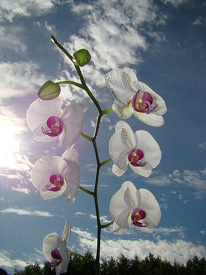
Providing orchids with optimal temperature and humidity is critical to their health and development. Fortunately, Just Add Ice Orchids are one of the hardiest orchid species. Phalaenopsis orchids thrive within a fairly wide range of temperatures and enjoy a slight dip in temperature at night. These popular orchid plants thrive in daytime temperatures ranging between 65 and 80 degrees with a nighttime temperature drop to between 60 and 70 degrees. Phalaenopsis orchids also prefer a somewhat moist environment, thriving when humidity levels are between 55% and 75%. While Phalaenopsis orchids are not as sensitive to temperature and humidity as some more fragile orchid species, too much of a good thing can have disastrous results.
When Just Add Ice Orchids are exposed to excessively high temperatures or humidity levels that are higher than optimal for any length of time, they are at risk of developing orchid bacterial or orchid fungal diseases. Bacteria and fungus thrive and reproduce rapidly in hot humid environments. If they attack your orchid and are not treated promptly, bacterial and fungal diseases can spread quickly, possibly causing permanent damage or even killing your Phalaenopsis orchid.
If your Just Add Ice Orchid shows signs of distress, it can be difficult to tell whether the problem is bacteria or fungus. If the leaves of your orchid are becoming discolored or your plant has a foul smell, a bacterial disease has most likely infected your plant. While bacterial diseases will not respond to fungicides, they should be treated with a fungicide in the same manner as orchids infected with fungal disease. Bacterial diseases weaken orchid plants, making them more susceptible to secondary fungal infection. Applying a fungicide prevents secondary infection and increases your orchid’s chance of recovery.
Photo by: jokestress
Next time: How to treat orchid bacterial and fungal diseases

Copyright Just Add Ice® Orchids 2023